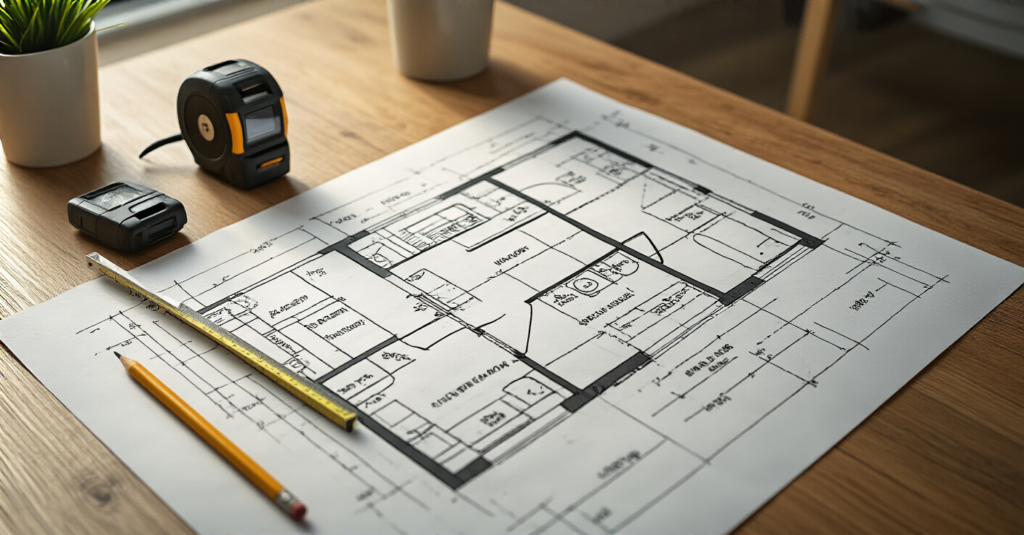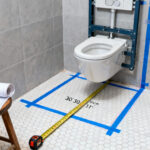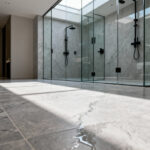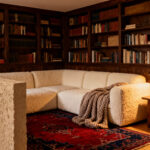I have a confession to make. Before I started blending my veterinary tech background with design, I used to think creating a beautiful home was simple. Then I brought home my rescue dog, Buster, a clumsy, happy-tailed beast of a Labrador mix. I’d just bought this super chic glass coffee table—you know the one, all sharp corners and minimalist cool. The first time he got the zoomies, he skidded, missed the corner by an inch, and my heart stopped. In that moment, I realized my “perfect” living room was actually a minefield for the creature I loved most.
That’s when everything clicked. Designing a home isn’t just about how it looks. It’s about how it lives, and for so many of us, that includes our pets. Forget the sterile, pet-free showrooms you see online. The real goal is creating a space that’s a safe, joyful haven for everyone in the family, two-legged and four. You don’t have to choose between a stylish home and a happy pet. You just have to be a little smarter about it.
Foundational Planning & Smart Layout Strategies
This is the boring-but-essential part, but I promise to make it interesting. Think of this as creating the blueprint for a home where your dog can chase his tail without knocking over a lamp and your cat has a safe perch to judge you from. Getting this right from the start saves you headaches, vet bills, and a whole lot of “NO, drop it!” moments.
1. Accurately Measure Your Space for Ideal Furniture Fit
You’ve probably heard this a million times, but I’m going to say it again with a twist: measure for your pet, not just your sofa. Yes, you need to know if that beautiful couch will fit through the door. But you also need to know if there’s enough space around it for a 70-pound Golden Retriever to do a full-body shake without taking out a side table. It’s about more than just furniture; it’s about life.
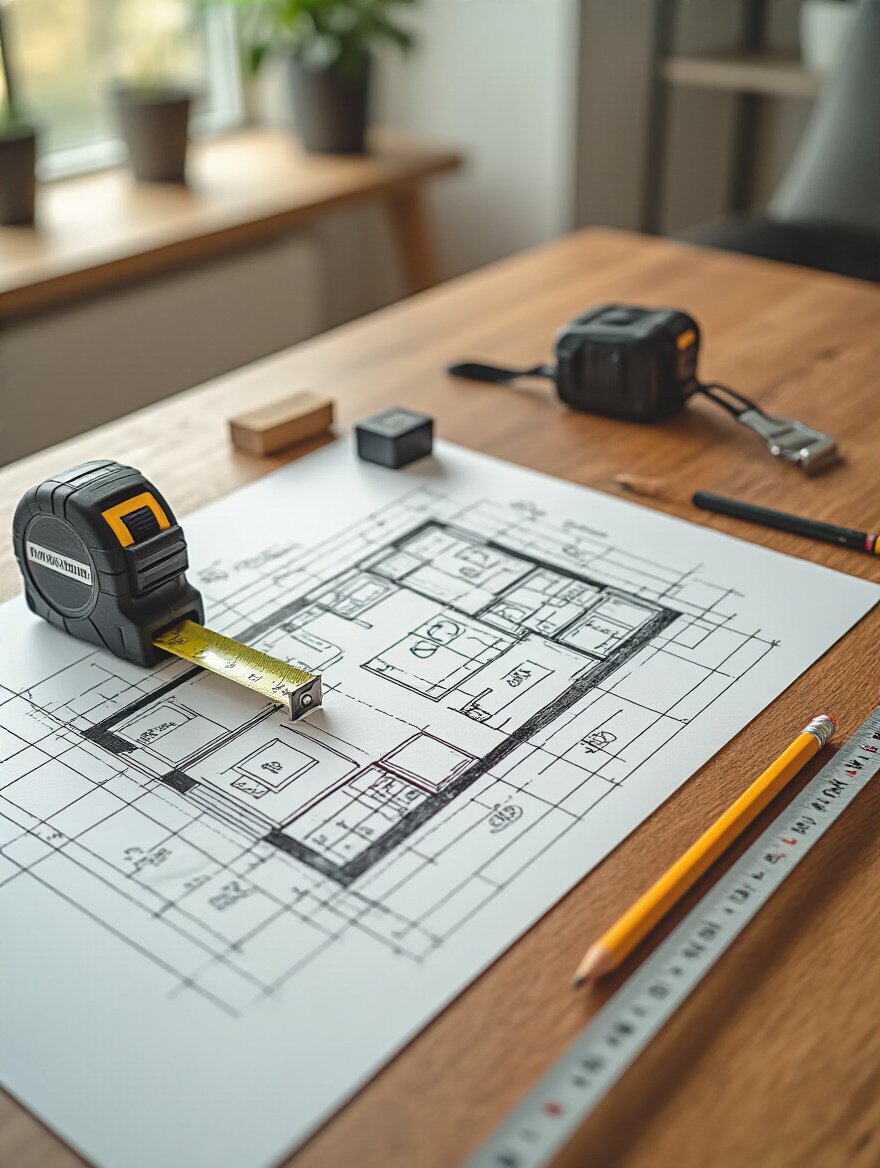
So, when you’re taping out the dimensions of that potential sectional on the floor, also tape out the dog bed, the cat tree, and the food bowls. Visualize your pet’s daily path. Is their “zoomie lane”—that clear runway they use to burn off energy—obstructed? Blocked pathways are a recipe for knocked-over drinks and, worse, a panicked animal crashing into a sharp corner. Think of open floor space as a safety feature.
A clear path is everything, which brings us to the next point…
2. Map Out Traffic Flow to Optimize Seating Arrangement
Interior designers talk about traffic flow for humans, but I call it mapping the “Runway and the Relaxation Zones.” Your pet needs clear, predictable paths to move through the space without feeling trapped or stressed. This is especially true for shy or reactive animals who need an easy escape route to their safe space.
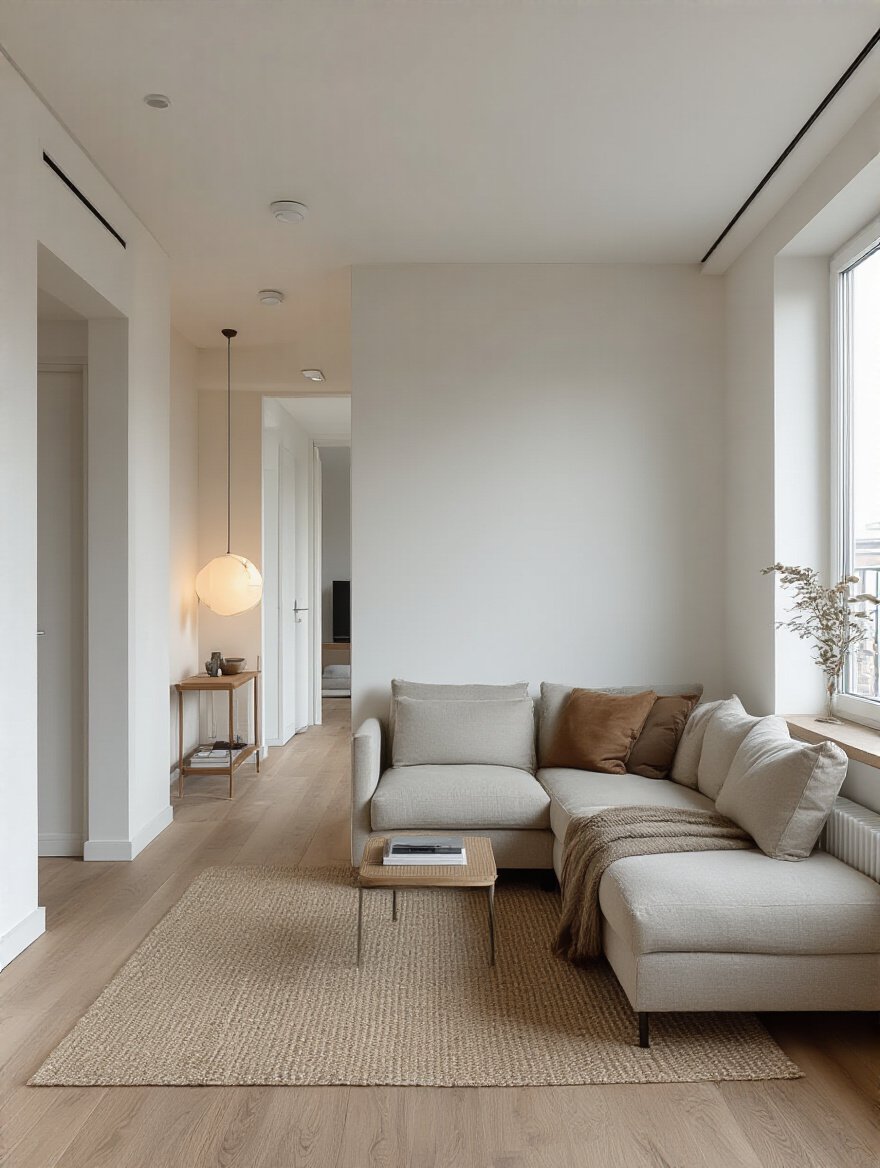
Start by identifying the main animal highways. These usually lead from the door to the sofa, from the sofa to their bed, and from their bed to the food bowls. Whatever you do, don’t block these paths with furniture. Think about how you arrange your seating. Is it creating a dead end? A good layout flows, allowing a dog to trot happily from room to room or a cat to slink along the walls without navigating an obstacle course. This isn’t just for convenience; it’s for their mental well-being.
Once you know where everyone will be walking (or running), you can start giving each activity a home.
3. Define Your Living Room’s Primary Functional Zones Clearly
Zoning isn’t just for open-plan offices; it’s a sanity-saver in a pet-friendly apartment. You’re not just creating a “living zone” and a “work zone.” You’re creating a “cuddle-on-the-couch zone,” a “durable-play-and-chew-toy zone,” and a “please-don’t-walk-across-my-keyboard-during-a-Zoom-call zone.”
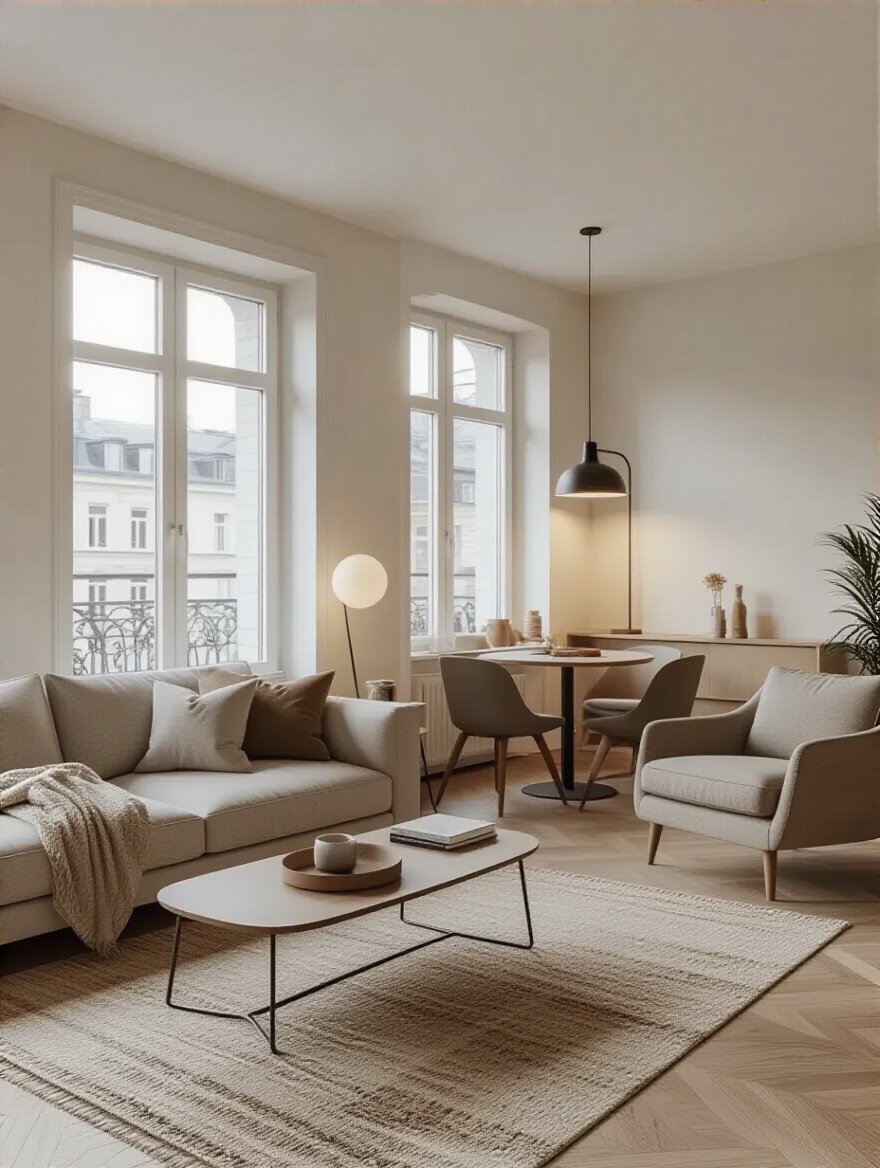
Use furniture and rugs to create these invisible boundaries. For instance, a durable, low-pile rug can define the main living area where toys are welcome. A different rug or even just empty floor space can signal the “dining” area, where you’d rather not have a game of fetch happening. And that little nook by the window? That’s the cat’s “sunbathing and bird-watching station.” Giving your pets their own designated spots makes them feel secure and makes it easier for you to keep the whole space feeling harmonious.
Now let’s talk about what to put in those zones.
4. Choose Appropriately Scaled Furniture for Compact Spaces
Here’s the deal: “appropriately scaled” for a pet owner means something different. It’s not just about visual weight; it’s about physical sturdiness. That delicate, spindly-legged side table might look airy and light, but one whack from a happy dog’s tail will send it flying. That lightweight accent chair? It becomes a sled when your cat launches off the back of it.

Look for furniture with a solid, low center of gravity. Think sofas with blocky feet or chairs with a substantial base. If you love the look of exposed legs, opt for metal over wood, as wood can become an impromptu chew toy for a teething puppy. It’s a balance between pieces that don’t visually overwhelm your small space but also won’t literally be overwhelmed by your pet.
Once you have your sturdy anchors, you can build the room around a star player.
5. Select a Central focal point to Anchor Room Design
Forget a fragile piece of art or a complicated media unit. In a pet-centric home, your focal point should be both beautiful and indestructible. Why not make it something that serves your pet, too? A stunning, well-built cat tree or a custom set of beautifully crafted climbing shelves can be a work of art that also enriches your cat’s life.
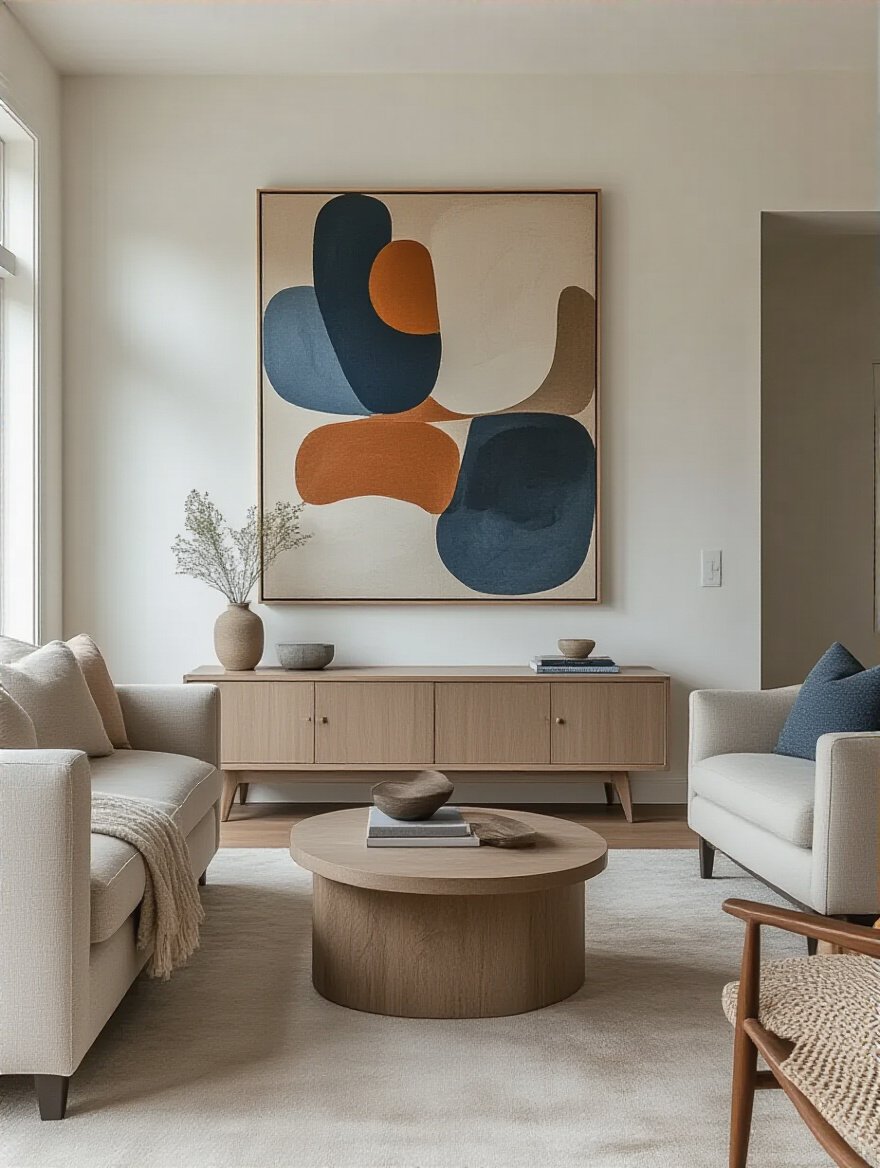
Or, if you have a big window with a great view, make that the focal point. Arrange your furniture to look out, and place a comfy, washable pet bed right in the sunniest spot. Your focal point is what draws the eye and organizes the room. By making it something both you and your pet can enjoy, you’re designing a space that celebrates your shared life, rather than trying to hide the pet-related parts away.
Before you haul anything home, let’s play make-believe.
6. Sketch a Digital Floor Plan to Visualize Layout Options
This is your secret weapon. Before you spend a dime or throw your back out, use a free online tool to create a digital floor plan. But don’t just plop in a sofa and a TV stand. Add in the pet elements. Most of these tools have generic shapes you can resize, so make one for the litter box, one for the crate, and one for the food station.
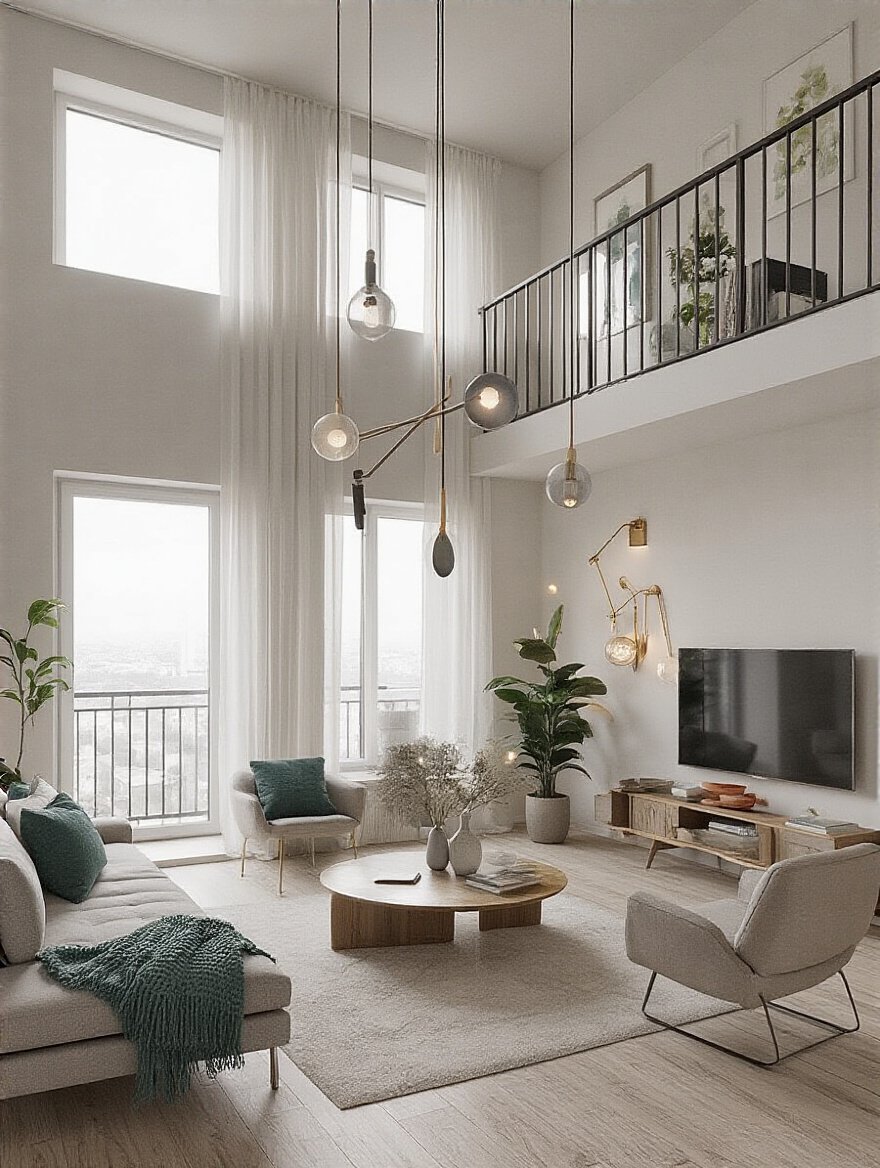
This is where you can solve problems before they happen. “Oh, the only place for the litter box is right next to the air vent? Bad idea.” “Whoops, the dog’s crate blocks the path to the balcony.” It also helps you visualize those all-important traffic lanes we talked about. A few minutes of dragging and dropping virtual furniture can save you from a layout that looks good in your head but is a total failure in reality for your furry roommate.
With a solid plan, it’s time to pick the all-star players.
Maximizing Space with Clever Furniture & Storage Solutions
In an apartment, every piece of furniture needs to earn its keep. For pet parents, it needs to work a double shift. It has to look good, serve a function for you, and somehow stand up to claws, fur, and the occasional bout of chaos. This is where we get smart and sneaky.
7. Invest in Multi-functional Furniture for Dual Purpose
A storage ottoman is the pet parent’s best friend. It’s a footrest, extra seating for guests, and most importantly, a magic box where all the squeaky toys and half-chewed bones disappear at the end of the day. A tidy living room is instantly achievable. Look for one with a sturdy, flat top that can double as a coffee table (with a tray on top).
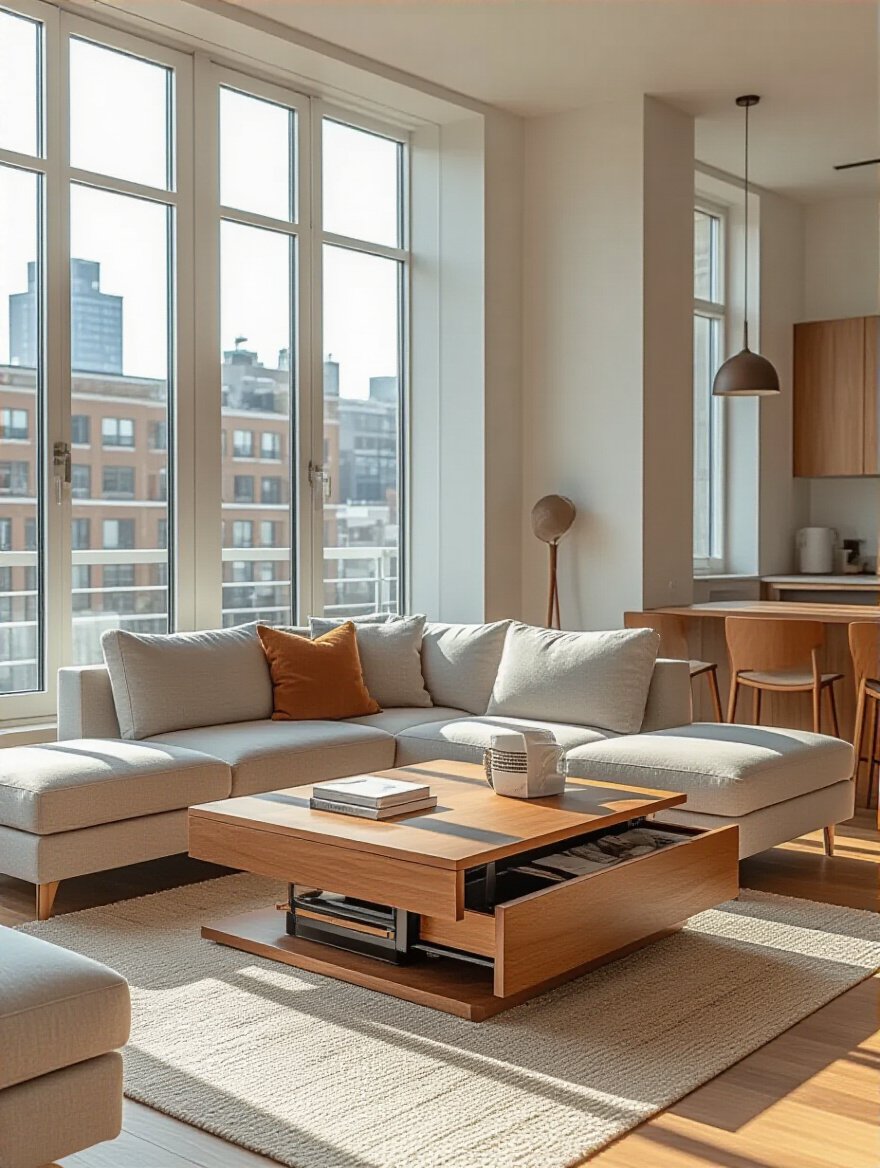
Just be mindful of the mechanics. If you opt for a lift-top coffee table that raises up to become a desk, make sure the hinge mechanism is slow-closing and won’t snap shut on a curious paw or nose. When it comes to multi-functional furniture, the key is to look for pieces that add convenience to your life without adding a new hazard to theirs.
Don’t just think horizontally; look up!
8. Utilize Vertical Wall Space for Essential Storage
When you have pets, floor space is prime real estate for play and naps. So, get everything else up off the floor! Walls are your untapped resource for storage. This is especially true for cat owners. A “cat-highway” of sturdy, well-anchored shelves gives your feline friend a place to climb, explore, and survey their kingdom from above—which drastically reduces their desire to climb your curtains or bookcases.
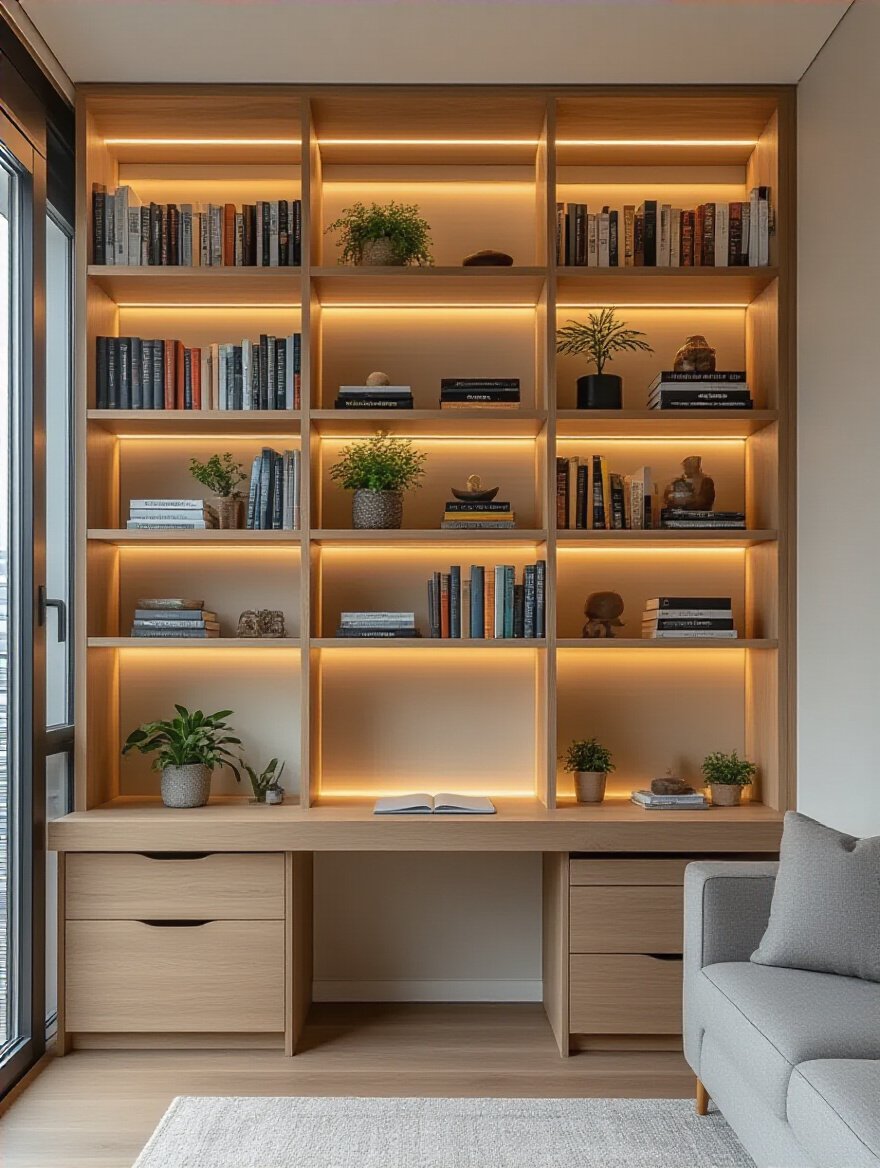
As a vet tech, I beg you: please install these shelves correctly. You must anchor them into studs. Drywall anchors are not enough for a leaping 12-pound cat. A fall can lead to broken bones and a massive vet bill. For everyone else, vertical shelves are a great place for books, plants (pet-safe ones only!), and decor, keeping them safely out of the path of a wagging tail.
Storage doesn’t have to be massive, it can be hidden in plain sight.
9. Opt for Ottoman or Coffee Table Storage to Conceal Clutter
This deserves its own point because it’s a game-changer. That growing mountain of rope-pulls, crinkle balls, and fuzzy mice can make even the most stylish apartment look like a pet store exploded. A large storage ottoman or a trunk-style coffee table is the perfect solution. It provides a designated, easy-to-access home for all that stuff.
The shortcut here is fabric choice. Choose performance fabrics that are easy to wipe clean or durable, tightly-woven materials that won’t snag on claws. Or, go for faux leather or a smooth-surfaced trunk that you can easily wipe drool or fur off of. At the end of the night, you can do a quick 2-minute “toy sweep,” and reclaim your adult living space in an instant.
Now for the seating that surrounds it.
10. Choose Slim-Profiled Seating to Preserve Openness
This is where I disagree with some designers. They’ll tell you to get furniture with high, skinny legs to create a sense of space. That’s true, but for a pet owner, those skinny wooden legs look a lot like a designer chew toy. And for cats, they’re the perfect-height scratching post.

If you love that airy look, here’s the trick: opt for seating with thin metal legs. They’re less appealing to chewers and can’t be shredded by claws. Another great option is a “waterfall” style sofa or chair where the fabric goes all the way to the floor, eliminating the temptation altogether. You can still have a sleek, non-bulky piece of furniture without accidentally providing your pet with an expensive bad habit.
For surfaces, think like a magician: now you see them, now you don’t.
11. Incorporate Nesting Tables for Flexible Surface Area
Nesting tables are brilliant for apartment living, but you need to choose wisely. A flimsy, lightweight set can be a disaster waiting to happen. Imagine your big dog wagging his tail and sending all three tables, and whatever is on them, crashing to the floor.
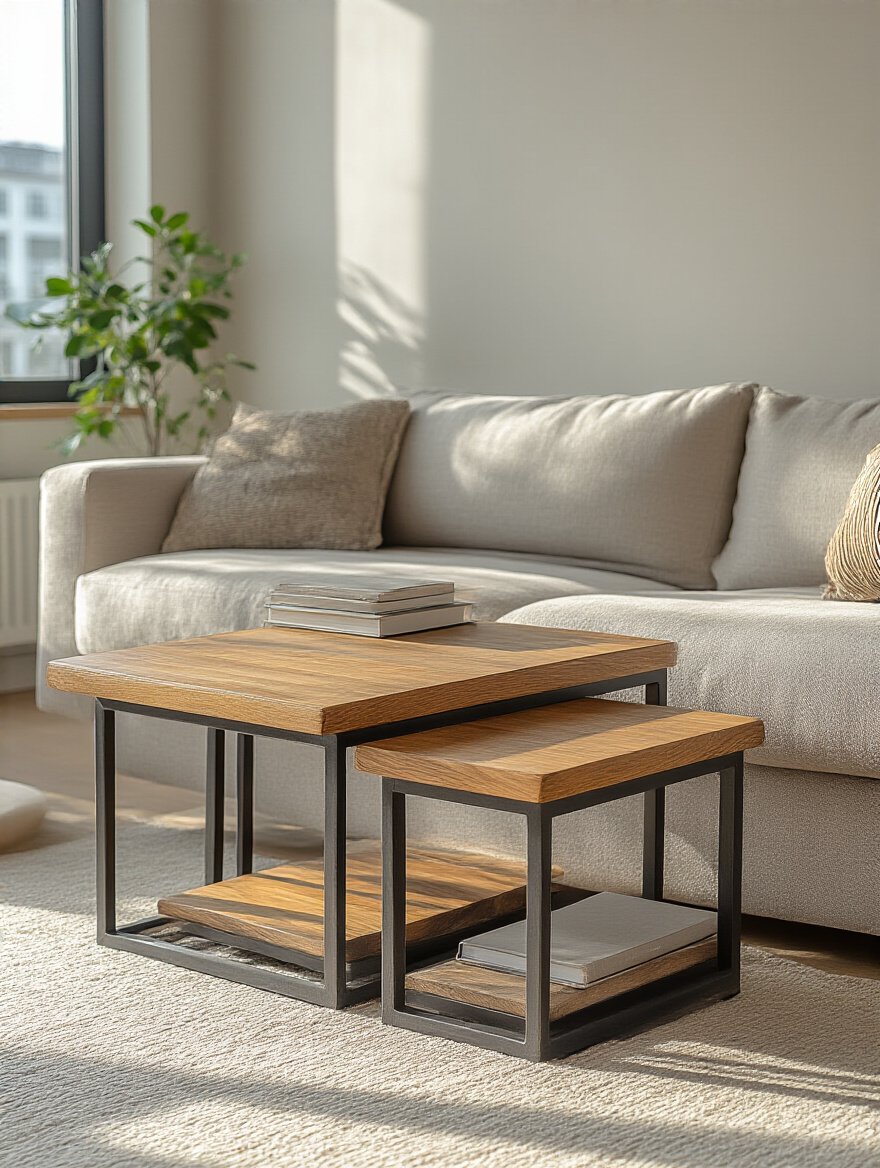
Look for sets that have some heft to them. The largest table should be substantial and stable enough to serve as your primary end table. When you pull the smaller ones out for guests, place them in low-traffic areas, tucked right next to a chair or sofa arm where they’re less likely to get bumped. It’s all about providing flexible surfaces without creating a new set of dominoes for your pet to topple.
Another great way to get things off the floor is with shelves, but there’s a right way and a wrong way.
12. Add Floating Shelves Instead of Bulky Bookcases
I love floating shelves for apartments. They keep things off the floor and draw the eye upward, making the room feel bigger. For cat owners, as we’ve said, they’re a non-negotiable for environmental enrichment. They are your cat’s personal jungle gym.
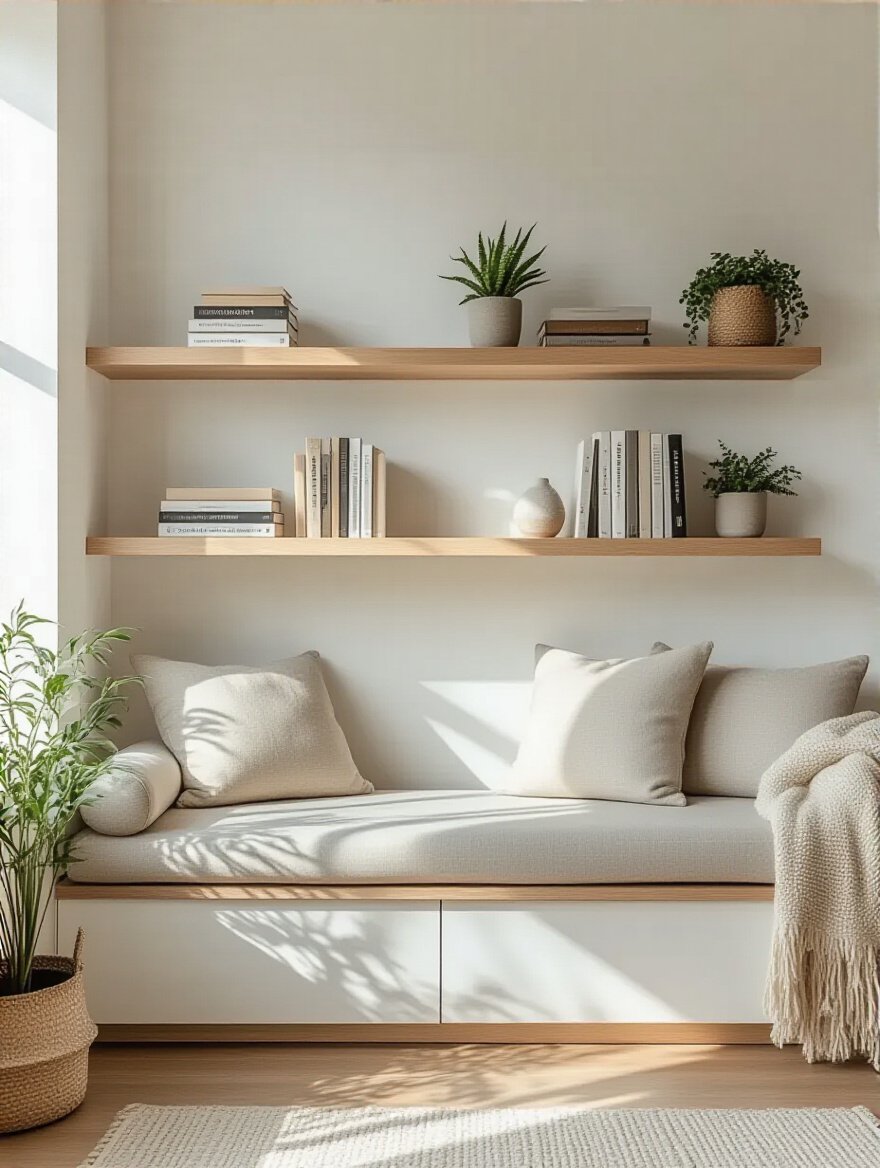
But here’s the BS advice: “Just hang them anywhere!” No. Never. Floating shelves carrying anything heavier than a couple of paperbacks must be anchored directly into wall studs. A stud finder is a non-negotiable $15 investment that could save you a $2,000 emergency vet visit. I once had a client whose improperly installed “cat-walk” shelf gave way. The cat was fine, thankfully, but the antique vase on the shelf below was not. Secure them properly, and they’re one of the best pet-friendly design choices you can make.
Now that the bones of the room are in place, let’s make it pretty (and safe).
Elevating Aesthetics with Color, Light & Decor
This is the fun part, where we add personality and warmth. These details are what make a house a home. But every choice, from the color of your walls to the pillows on your sofa, can be made with your pet in mind to create a space that’s not only beautiful but also practical and safe.
13. Implement Layered Lighting for Versatile Ambiance Control
Good lighting is everything, but for a home with pets, “good” also means “safe.” Those elegant, skinny floor lamps that look so chic in photos can be a serious tipping hazard for a rowdy dog or a climbing cat. And the long, dangling cords are an open invitation for a curious pet to chew, which can be fatal.

The shortcut is to focus on heavy-based lamps that are hard to knock over. Run cords behind furniture or use cord concealers that stick to your baseboards. For an extra layer of safety and style, consider wall sconces. They provide beautiful ambient light with no cords or bases to worry about. Layering your light with a mix of safe overhead, sconce, and table lamps gives you control over the mood without creating a danger zone.
Light is great. Reflected light is even better.
14. Use Mirrors Strategically to Reflect Light and Expand Room
Mirrors are a classic small-space trick, and they work wonders. But before you mount a giant one, a quick pet-check. Most animals figure out that the “other dog” in the mirror is just a reflection, but some can get stressed or fixated. It’s rare, but something to be aware of.
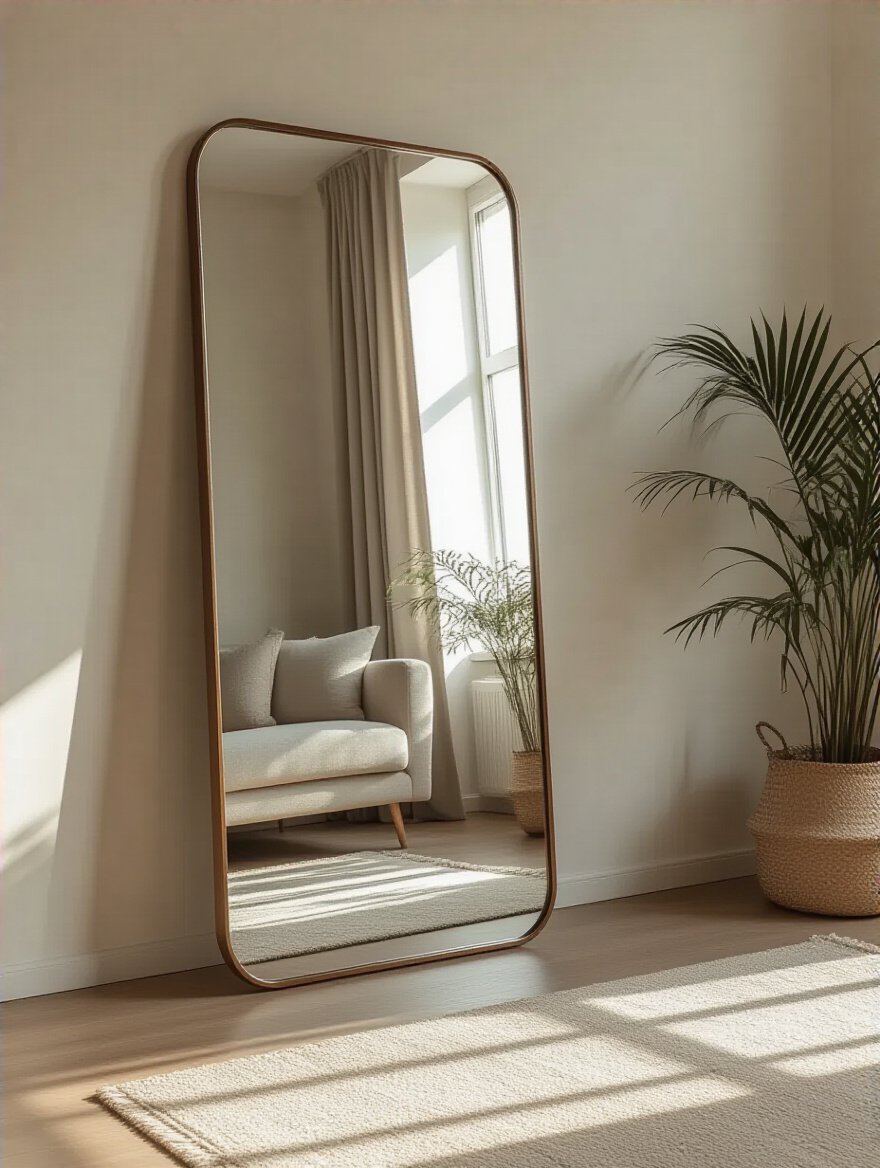
The main safety concern is making sure they are securely anchored to the wall. This is not the place for leaning a giant, heavy mirror against the wall, especially if you have a large dog or kids. A happy tail-thump or a game of chase could bring it crashing down. Secure it properly, and a mirror can make your room feel brighter and twice as big, giving you more visual bang for your buck.
Let’s talk color, specifically, fur-colored.
15. Select a Cohesive Color Palette for a Unified Look
Here’s the real story on color palettes for pet owners: your pet’s fur is part of your palette whether you like it or not. If you have a black lab, a pure white sofa is an act of masochism. You will be fighting a losing battle against fur forever. The shortcut? Embrace colors that are forgiving.
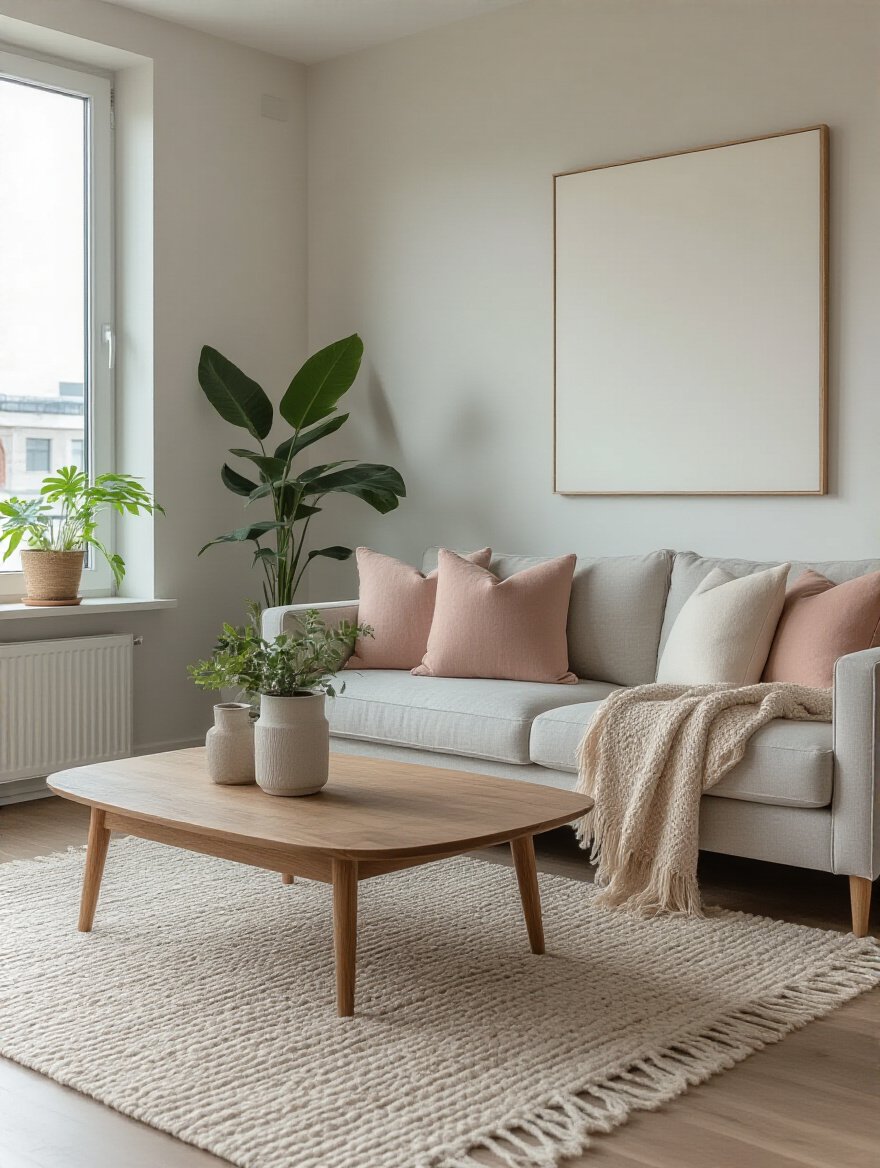
Look at your pet! Are they a warm golden-brown? Creams, beiges, and warm grays will be your friends. Do you have a gorgeous grey cat? A charcoal sofa will hide fur beautifully. This doesn’t mean your whole apartment has to be beige. Use your bold accent colors on things that are easy to clean or don’t attract fur, like art, painted furniture, or pillows with removable, washable covers. And always use a satin or eggshell paint finish on walls—it’s scrubbable!
Color is one part of the equation. Texture is the other.
16. Introduce Diverse Textures Through Textiles for Warmth
Textiles are where you can make the biggest impact on the durability and coziness of your living room. The BS everyone falls for is buying fabrics that look cozy but are a nightmare for pets. That trendy, open-weave, chunky-knit throw blanket? Your cat’s claws will turn it into a pile of yarn in five minutes.
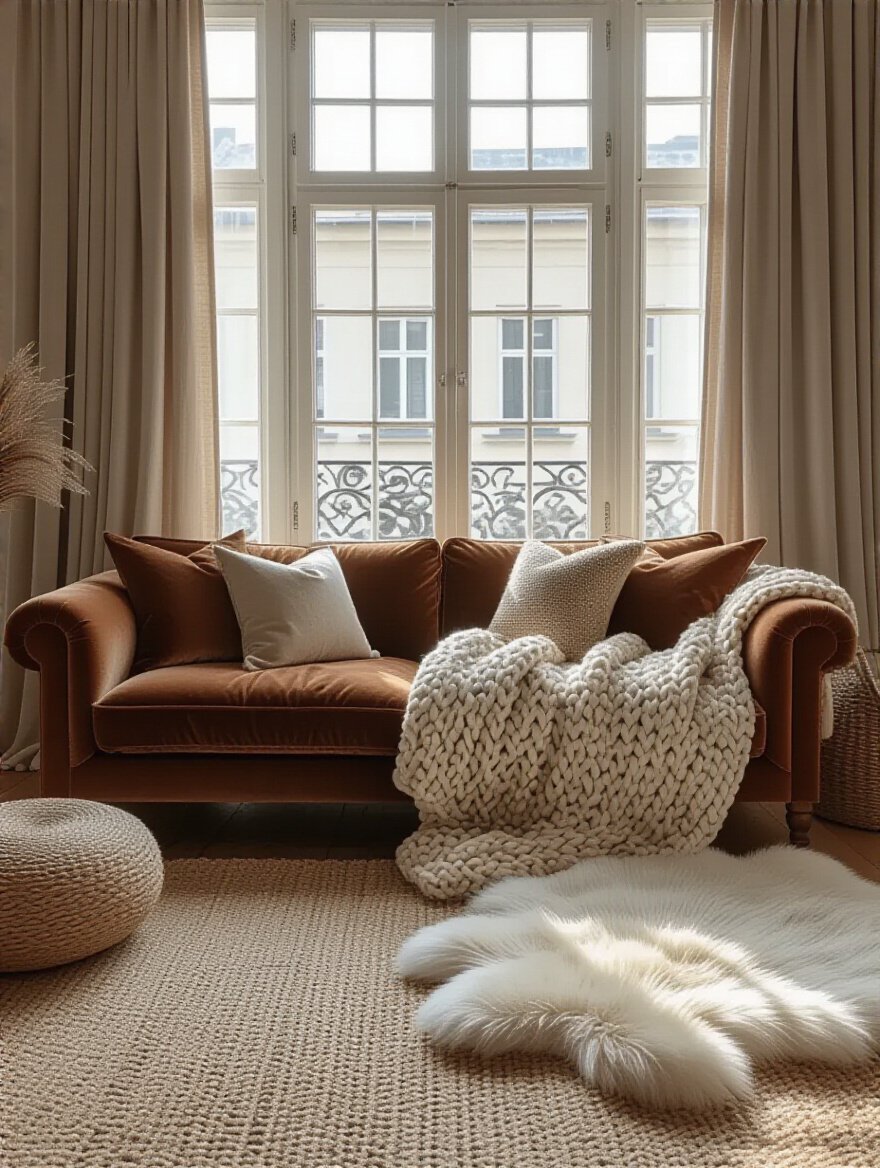
Instead, think “tight and tough.”
- Performance fabrics like Crypton or Sunbrella are amazing. They’re stain-resistant, liquid-repellent, and built to last.
- Microfiber and velvets with a short pile are great because there are no loops for claws to snag.
- Leather is durable and easy to wipe clean, but it can get scratched. Some people love the worn-in, patina look, others don’t.
- Avoid: Looped fabrics like Berber carpet, delicate silks, or anything with a lot of loose embroidery.
Layer these pet-friendly fabrics—a smooth velvet pillow, a tightly woven cotton throw, and a durable area rug—to create a space that feels rich and inviting, not precious and off-limits.
Speaking of things your pet might put in their mouth…
17. Integrate Greenery with Indoor Plants for Natural Vitality
I cannot stress this enough: so many common houseplants are toxic to cats and dogs. Before you bring a single plant into your home, you must check if it’s safe. Lilies (all kinds!) are incredibly deadly to cats. Sago Palms are highly toxic to dogs. Dieffenbachia, Pothos, Snake Plants… all common, all toxic if ingested.
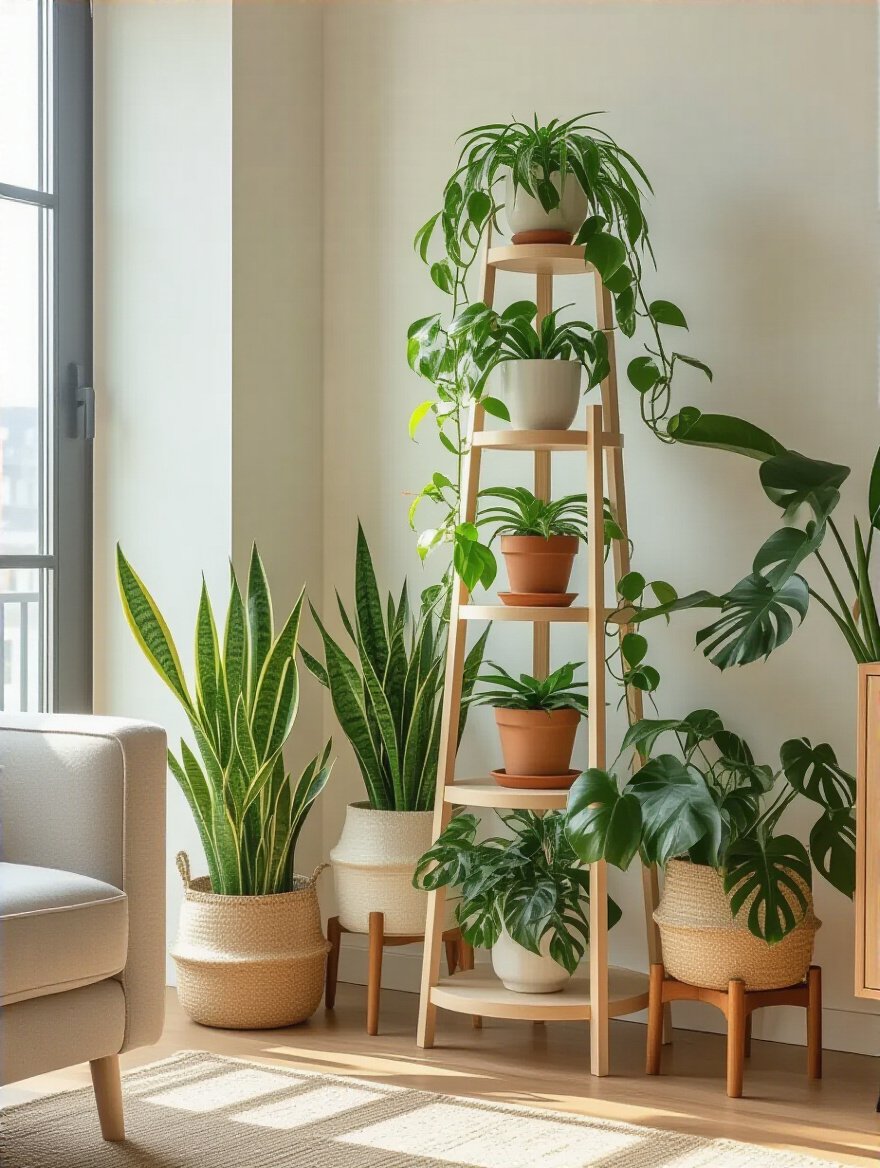
But don’t despair! You can still have a gorgeous indoor jungle. Just choose wisely. Here are a few of my favorite pet-safe beauties:
- Spider Plant
- Calathea (Prayer Plant)
- Boston Fern
- Areca Palm
- Haworthia (a succulent that looks like aloe)
Placing them in hanging planters or on high, sturdy shelves is another great way to keep them out of reach of a curious nibbler. Your living room gets the lush, green vibe without you having to rush to the emergency vet.
What about what goes on the walls?
18. Display Curated Art and Photography to Personalize Walls
Your walls are a canvas for your personality. Hang photos of your adventures, prints from artists you love, and of course, portraits of your furry best friend. The only rule is to hang it with care. A big, heavy piece of art needs to be hung securely, ideally on two hooks, so it won’t get knocked crooked by a vibrating wall from a dog barking.
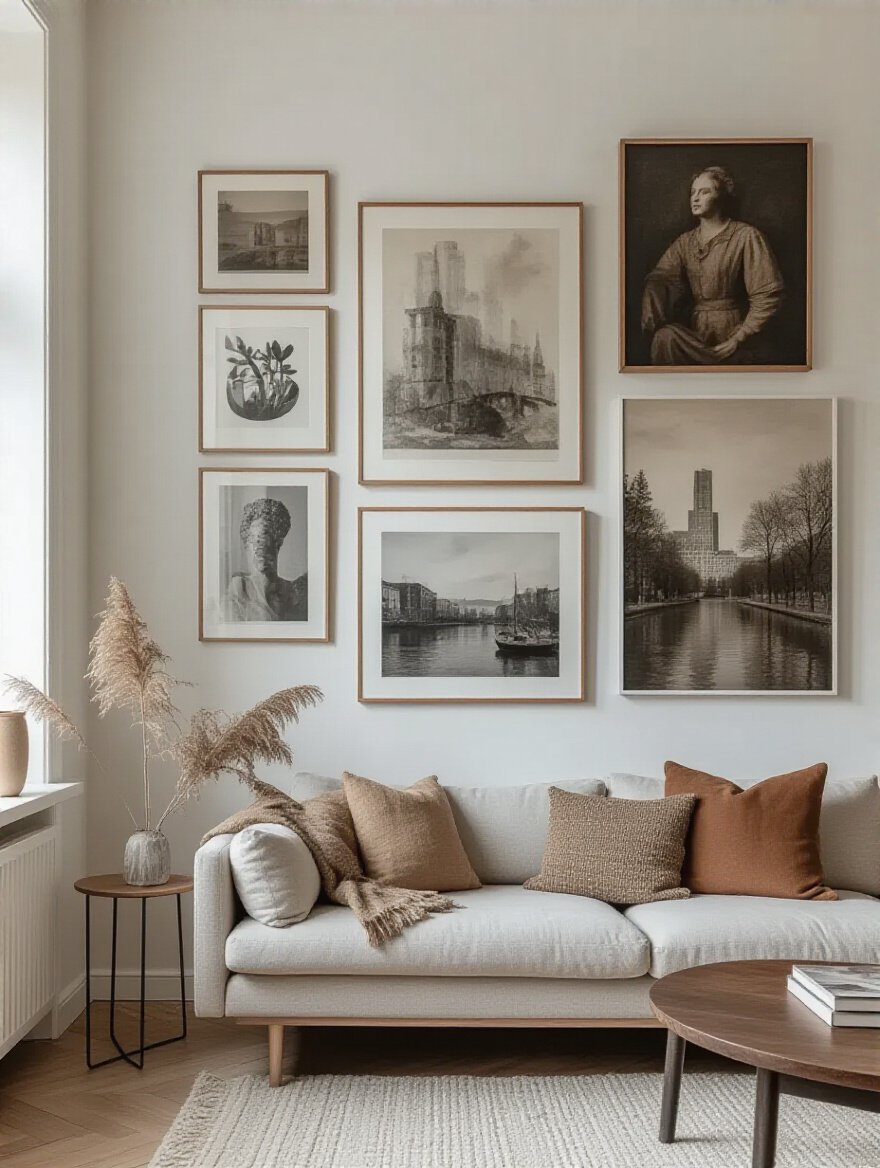
And think about the height. Is that beautiful framed photo hanging just at tail-wagging level? Maybe raise it a few inches. Consider using acrylic or plexiglass instead of real glass in frames that are in high-traffic areas. It’s lighter and won’t shatter into dangerous shards if it does get knocked down.
Now, let’s get into the nitty-gritty of making it all work day-to-day.
Personalization, Flow & Advanced Organizational Hacks
You’ve got the foundation, the furniture, and the style. This last part is all about the little tricks that keep your pet-friendly apartment looking great and functioning smoothly on a daily basis. These are the hacks that make you feel like you’ve really cracked the code.
19. Use Area Rugs to Define Distinct Functional Zones Clearly
Rugs are essential for zoning, but for a pet owner, they come with three non-negotiables: they must be durable, easy to clean, and non-slip. A rug that slides around on a hard floor is a serious hazard for a dog running to greet you at the door. It’s a slip-and-slide waiting to cause an injury. Always, always, always use a good quality non-slip rug pad.
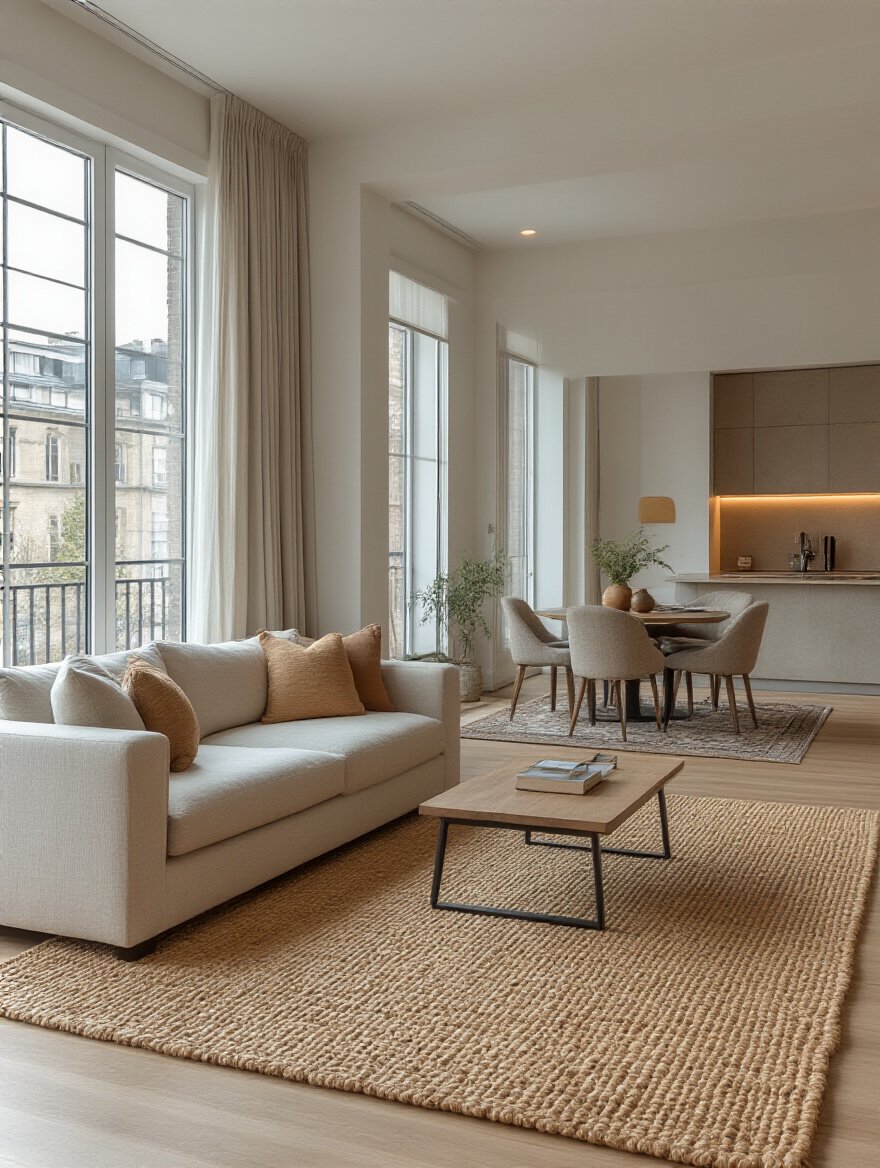
The best shortcut I know is to embrace washable rugs (like Ruggable or Tumble) or indoor/outdoor rugs. Indoor/outdoor rugs are made from polypropylene and are practically indestructible. You can literally take them outside and hose them down. They’re perfect for defining a “play zone” or putting under a dining area. Choose low-pile options that won’t trap as much fur and are easier to vacuum.
Once the floor is sorted, let’s tackle the small stuff.
20. Minimize Visual Clutter with Cohesive Storage Baskets
Storage baskets are fantastic, but materials matter. So many beautiful baskets are made of wicker or sea grass, which to a bored puppy or cat, looks like a delicious, shreddable snack. Ingesting these materials can cause serious gastrointestinal blockages.
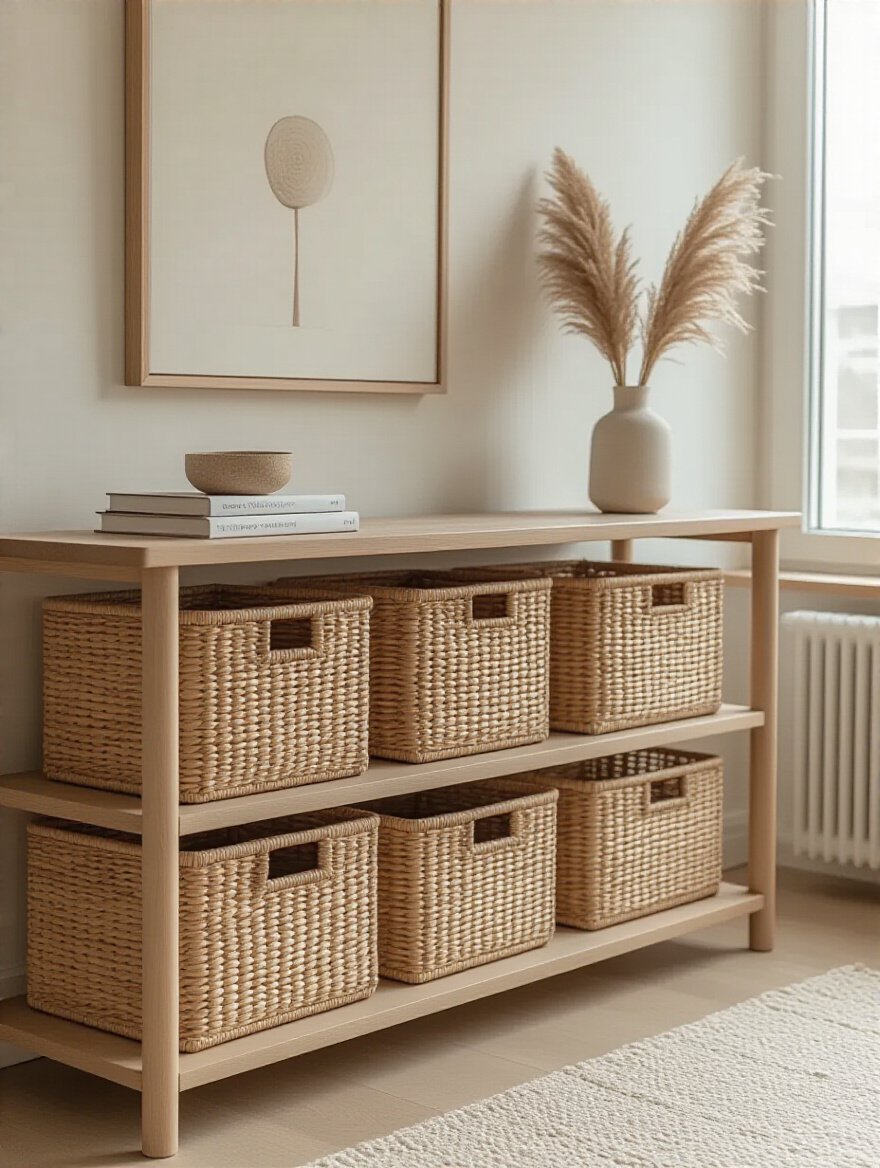
The safer, and still stylish, choice is to use baskets made of materials your pet won’t want to eat. Think soft felt, sturdy canvas, or sleek metal. Grouping a few identical baskets together on a shelf or under a console table creates a calm, cohesive look while keeping things like remote controls, chargers, and (non-chewable) pet supplies tidy and out of sight.
Sometimes, you need that storage to come to you.
21. Incorporate Rolling Carts for Mobile Storage Solutions
A rolling cart can be a bar cart one night and a mobile home office the next. It’s a genius piece for small spaces. The key for a pet home is to get one with high-quality wheels that lock. A free-wheeling cart is an accident waiting to happen when bumped by a playful pet.
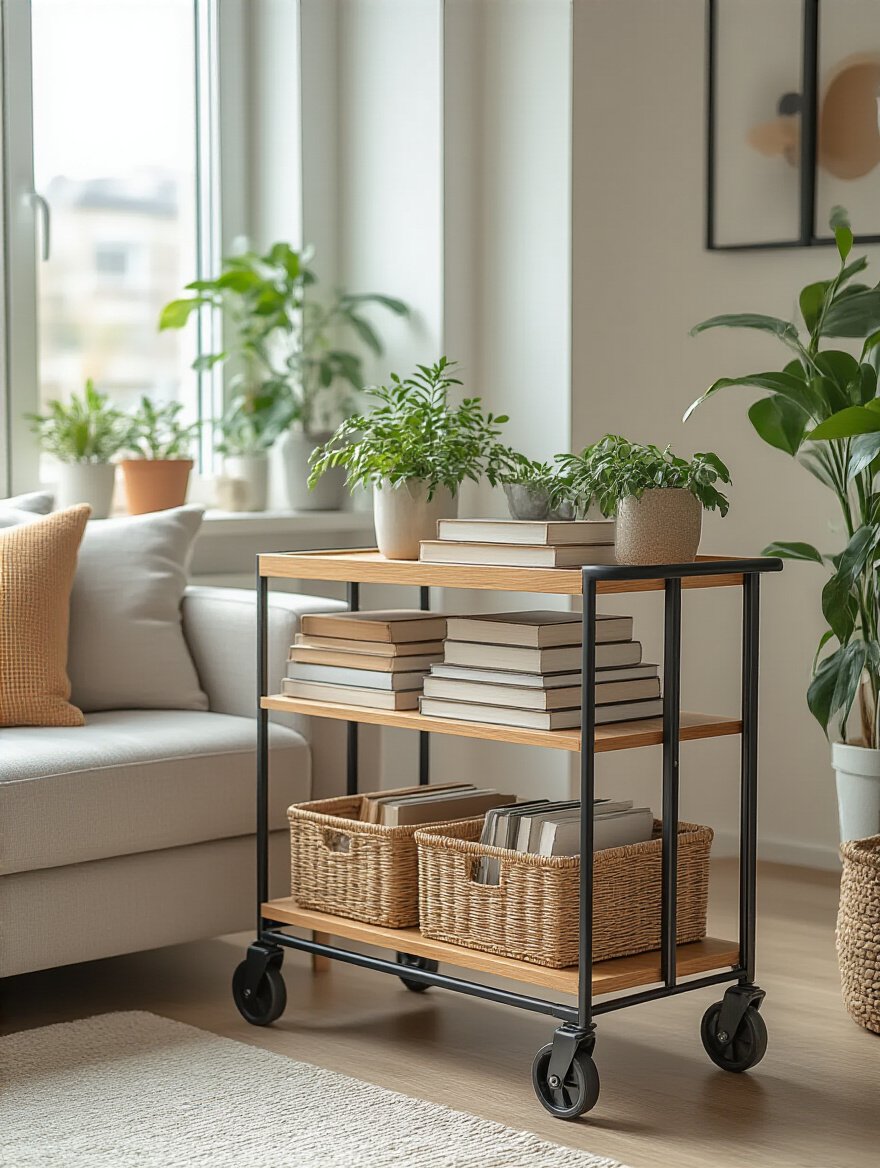
Use a cart to create a dedicated station. Maybe it’s a “pet spa” cart with brushes, nail clippers, and pet-safe wipes that you can roll into the living room for a grooming session. Or maybe it holds your craft supplies so you can work on a project while watching TV and then easily wheel it all away. Just be sure that whatever you store on it isn’t tempting or dangerous for your pet.
Let’s make sure the things you love stay safe.
22. Add Thoughtful Personal Touches Through Collected Decor
Your home should tell your story. Display those unique souvenirs from your travels and cherished family heirlooms. Just do it strategically. That fragile, irreplaceable vase your grandmother gave you? It does not belong on a low side table next to the sofa where a wagging tail can send it flying.
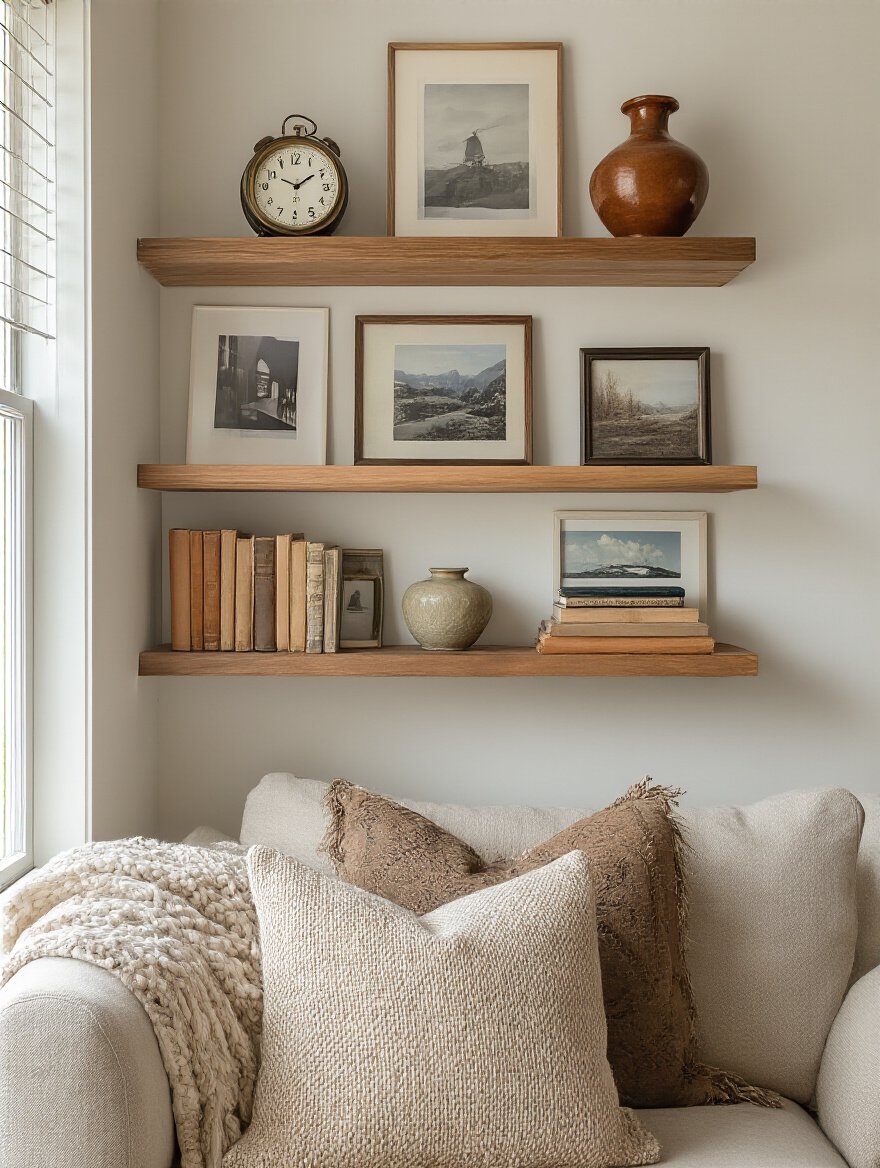
Create a “safe zone” for your most precious items. A high shelf, a glass-fronted cabinet (like an IKEA Billy bookcase with glass doors), or a floating picture ledge are perfect spots. You can still see and enjoy your treasures, but they’re safely out of the path of daily pet life. It’s not about hiding things away; it’s about curating your displays with a protective eye.
Speaking of protection, let’s talk about the biggest hidden danger in any home.
23. Optimize Electrical Outlets for Device Charging Convenience
This isn’t about convenience; this is about safety. Cord chewing is incredibly dangerous and can lead to severe electrical burns or death. As a vet tech, I’ve seen the tragic results. The mess of cables behind your TV or the phone charger snaking across the floor is an irresistible, deadly toy for some pets, especially puppies and rabbits.
Invest in cord protectors—the hard plastic tubing that wraps around cables. Bundle wires together and run them behind furniture or use adhesive clips to attach them to the back of a media console. Better yet, look for end tables or charging stations that have built-in outlets and cord management, keeping everything completely contained and out of reach. Making your charging setup neat isn’t just a design choice; it’s a critical safety measure.
Finally, the one trick that works every single day.
24. Regularly Declutter to Maintain a Fresh and Tidy Aesthetic
The most effective way to keep your apartment looking good is to own less stuff. For pet parents, decluttering is also a safety protocol. The less random stuff lying around on the floor and on low surfaces, the fewer opportunities your pet has to eat something they shouldn’t or knock something over.
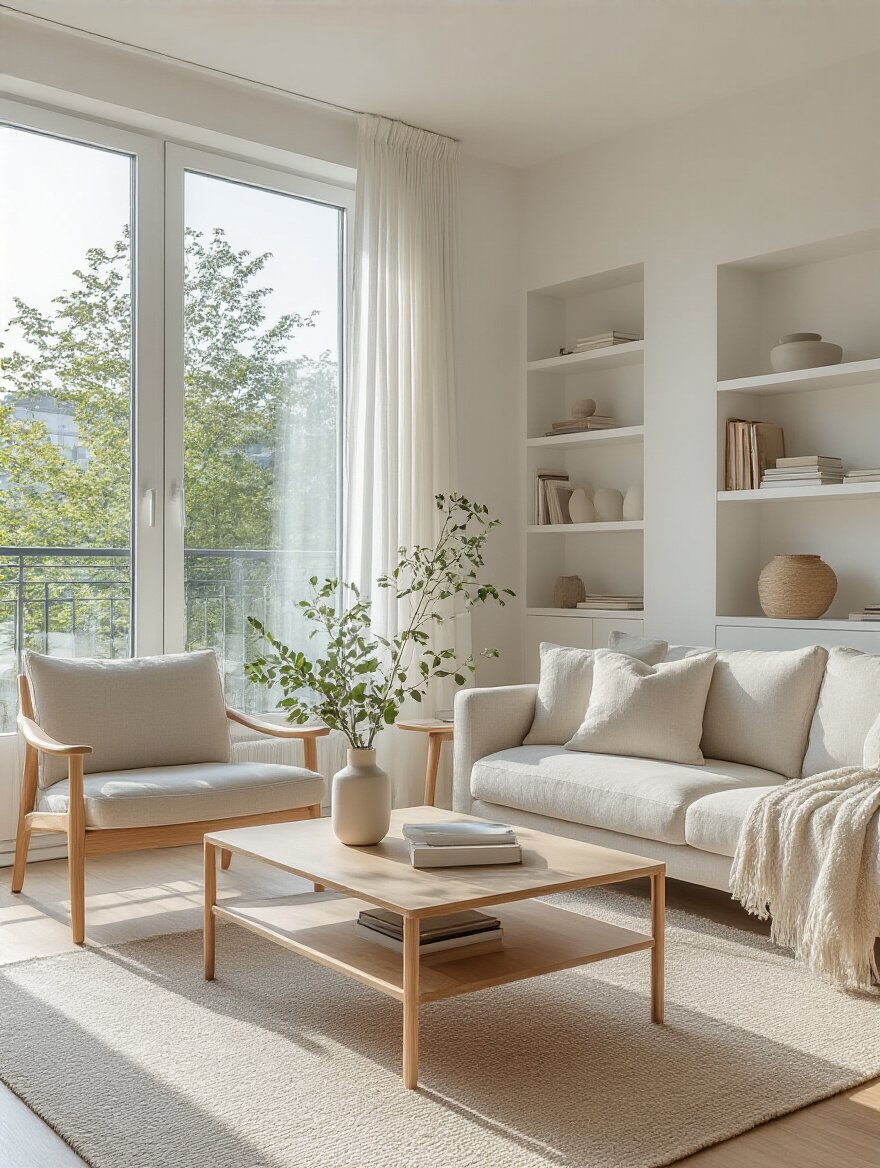
Embrace the “one-in, one-out” rule. When you buy a new toy, donate an old one. When you get a new decorative pillow, retire the one that’s seen better days. Do a quick 5-minute tidy every night before bed—put toys in their basket, fold the throw blanket, stack the magazines. This small, consistent effort prevents the chaos from building up and keeps your living room feeling like a calm, restorative oasis for both you and your best friend.
Conclusion
Creating a home that is both beautiful and truly pet-friendly isn’t about sacrifice. It’s about thoughtful, compassionate design. It’s looking at a room not just with an artist’s eye, but with a protector’s heart. It’s choosing the sofa that will hide the fur, the rug that won’t slip, the plant that won’t poison, and the layout that gives them room to be the joyful, silly, wonderful animals they are.
Your apartment doesn’t have to be a sterile, pet-proofed bunker or a chaotic fur-covered mess. By planning with your whole family in mind, you can create a space that feels expansive, stylish, and deeply personal. It’s a haven where you can relax, your guests feel welcome, and your pet can be safe, comfortable, and unconditionally loved. That’s not just good design; it’s a good life.
